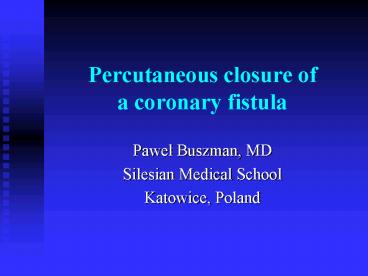Percutaneous closure of a coronary fistula - PowerPoint PPT Presentation
Percutaneous closure of a coronary fistula
Risk factors: BMI 32, arterial hypertension ... Chest X-Ray suggesting L to R shunt. On auscultation: systolic murmur over PA. Clinical data ... – PowerPoint PPT presentation
Title: Percutaneous closure of a coronary fistula
1
Percutaneous closure of a coronary fistula
- Pawel Buszman, MD
- Silesian Medical School
- Katowice, Poland
2
Clinical data
- Male,40 year old
- Angina, CCS class 3
- Risk factors BMI 32, arterial hypertension
- Tredmil stress test 6 min., 7 METs, limited by
angina and ST changes in precordial leads - Chest X-Ray suggesting L to R shunt
- On auscultation systolic murmur over PA
3
Clinical data
- UKGLVEDD/LVESD 52/38 mmLVEF 55RV 33
mm - Normal LV and valves function, no IVS or IAS
defect
4
Coronary angiography
LAD-PAfistula
LAD-PAfistula
S1
IMA
LCA RAO30/Caud15
LCA left lateral view
5
Should the fistula be treated?
- Clinical symptoms
- Myocardial ischaemia on stress test
- Features of L-R shunt on chest X-Ray
The answer is YES
6
Percutaneous closure of the coronary fistula
Jomed coronary graft stent on balloon 4.0 mm
LCA RAO30/Caud15post stent-graft implantation
7
6 month follow-up
- No angina
- Tredmil stress test85 of MHR, 10 METS, no
ischemia on ECG, - A control angio no restenosis
8
6 month coronary angiography
LCA RAO30/Caud15 6 month follow-up
LCA LL90
9
Conclusions
- Coronary fistula can be completely closed with a
graft stent. - Beacause of the risk of in stent restenosis a
control coronary angiography should be taken
after 6 month.
PowerShow.com is a leading presentation sharing website. It has millions of presentations already uploaded and available with 1,000s more being uploaded by its users every day. Whatever your area of interest, here you’ll be able to find and view presentations you’ll love and possibly download. And, best of all, it is completely free and easy to use.
You might even have a presentation you’d like to share with others. If so, just upload it to PowerShow.com. We’ll convert it to an HTML5 slideshow that includes all the media types you’ve already added: audio, video, music, pictures, animations and transition effects. Then you can share it with your target audience as well as PowerShow.com’s millions of monthly visitors. And, again, it’s all free.
About the Developers
PowerShow.com is brought to you by CrystalGraphics, the award-winning developer and market-leading publisher of rich-media enhancement products for presentations. Our product offerings include millions of PowerPoint templates, diagrams, animated 3D characters and more.































